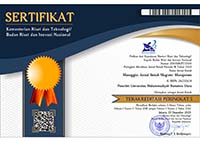Sensitivity Analysis Of Business Feasibility Using Palm Kernel Cake (PKC) Solid Waste In Composing Of Palm Oil Leaf
Abstract
Keywords
Full Text:
PDFReferences
Alienda N, 2004. Pengaruh Beberapa Jenis Aktivator terhadap Kecepatan Proses Pengomposan dan Mutu Kompos dari Sampah Pasar dan Pengaruhnya terhadap Pertumbuhan dan Produksi Tanaman Caisim (Brassica juncea L) dan Jagung Semi (Zea mays L). Skripsi. Bogor. Institut Pertanian Bogor.
Djuarnani N, Kristian, Budi SS. 2005. Cara Cepat Membuat Kompos. Depok: Agro Media Pustaka.
Djuarnani, N. 2008. Cara Cepat Pembuatan Pupuk Kompos. PT Agromedia Pustaka, Jakarta.
Husein, U. 2003. Metode Riset Akuntansi Terapan. Jakarta : Ghalia Indonesia.
Husnan, S, dan Suwarsono. 2000. Studi Kelayakan Proyek (4th ed.). Yogyakarta: Unit Penerbit dan Pencetak (UPP) AMP YKPN.
Indriani, Y. H, 2002, Membuat Kompos Secara Kilat. Cet. 4, Penebar Swadaya, Jakarta.
Indriani, Y. H, 2012. Membuat Kompos Secara Kilat. Penebar Swadaya. Jakarta.
Isroi, 2007. Kompos. Makalah Disampaikan pada Acara Study Research Siswa SMU Negeri 81 Jakarta. 1-2 Februari 2008. BPBPI, Bogor.
Kawamoto, H., Mohamed, WZ, Shukur, NIM., Ali, MSM, Ismail, Y. and Oshio, S. 2001. Palatability, digestibility, and voluntary intake of processed oil palm fronds in cattle. JARQ 35(3); 195-200.
Pusat Penelitian Kelapa Sawit (PPKS). 2005. Budidaya Kelapa Sawit. Pusat Penelitian Kelapa Sawit. Medan.
Rahman, MM., Lourenco M, Hassim HA, Boars JJP, Sonnenberg ASM, Cone JW, De Boever J, and Fievez V. 2011. Improving ruminal degradability of oil palm fronds using white rot fungi. Anim. Feed. Sci. and Tech. Vol. 169, Issues 3-4. Pages. 157-166.
Sahmadi, 2006. Pengaruh Intensitas pencahayaan terhadap arah pertumbuhan kelapa sawit. Departemen Pertanian Fakultas Pertanian USU,Medan.
Starbuck, C. J. 2004. Waste Management Alternative Composting. University of Nottingham School of Biociences. Scientific Program, Nottingham.
Sumekto, Riyo. 2006. Pupuk Pupuk Organik. PT Intan Sejati. Klaten.
Sufa, M.F. 2007. Analisis sensitivitas pada keputusan pembangunan meeting hall untuk minimasi resiko investasi. Jurnal Ilmiah Teknik Industri, 5(3), 97-105.
Soekartawi. 2006. Ilmu Usahatani. UI Press: Jakarta.
Tchobanoglous, G., Frank., and Keith. 2002. Handbook of Solid Waste Management Second Edition. Mc.Graw-Hill, New York.
Widiastuti, R dan Syabana, D.K. 2012. Serat Pelepah Kelapa Sawit (SEPAWIT) Untuk Bahan Baku Produk Kerjinan. Balai Besar Kerajinan dan Batik.Yogyakarta.
Yurmiati, H., Hidayati, Y. A. 2008. Evaluasi produksi dan penyusutan kompos dari feses kelinci pada peternakan rakyat. Jurnal Seminar Nasional Teknologi Peternakan dan Veteriner Universitas Padjadjaran, Bandung.
DOI: https://doi.org/10.30596/jasc.v4i2.6638
Refbacks
- There are currently no refbacks.
JASc (Journal of Agribusiness Sciences)
Fakultas Pertanian Universitas Muhammadiyah Sumatera Utara
Kampus Utama
Jl. Kapten Muchtar Basri No.3, Glugur Darat II,Medan
Sumatera Utara-20238
E-mail: jasc@umsu.ac.id
This work is licensed under a Creative Commons Attribution-ShareAlike 4.0 International License.
View My Stats






